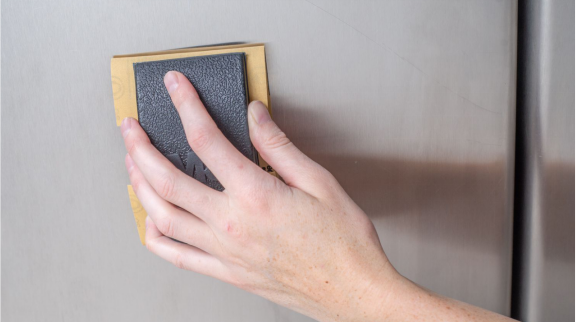Stainless steel appliances are known for their sleek and modern appearance, making them a popular choice in many kitchens and households. However, over time, even the most well-maintained stainless steel surfaces can develop scratches and blemishes, detracting from their beauty. While professional restoration services are available, you can save time and money by attempting to remove minor scratches yourself. With a few simple tools and a bit of patience, you can restore your stainless steel appliances to their former glory. In this DIY guide, we will walk you through the step-by-step process of removing scratches from stainless steel appliances.
Understanding Stainless Steel and Scratches
Before delving into the restoration process, it’s essential to understand the nature of stainless steel and the various types of scratches you might encounter. Stainless steel is a durable and corrosion-resistant material composed of a mix of metals, primarily iron, chromium, and nickel. Its resistance to rust and staining is due to the chromium content, which forms a thin, invisible layer of oxide on the surface that protects it from corrosion.
Scratches on stainless steel appliances can be categorized into three main types:
- Surface Scratches: These are shallow and minor scratches that only affect the topmost layer of the stainless steel. They are the easiest to remove and typically don’t compromise the overall integrity of the appliance.
- Deeper Scratches: These scratches extend beyond the surface layer and can be more challenging to remove. While they might not be as aesthetically pleasing as surface scratches, they can often be significantly improved.
- Gouges and Dents: These are the most severe forms of damage, where the stainless steel surface is deeply cut or indented. Repairing such damage might require professional assistance, and complete restoration may not always be possible.
Tools and Materials:
- Sandpaper (Various Grits): You’ll need sandpaper of different grits, such as 400, 800, and 1200. Lower grit numbers indicate coarser sandpaper, while higher numbers indicate finer grit.
- Wire Brush: Choose a wire brushwith soft bristles to avoid scratching the stainless steel further.
- Microfiber Cloths: Soft and lint-free cloths are essential for cleaning and polishing.
- Warm Soapy Water: To clean the surface before and after using sandpaper or a wire brush.
- White Vinegar: For stubborn stains and additional cleaning.
- Olive Oil or Mineral Oil: For polishing and restoring shine.
- Rubbing Alcohol: To clean the surface before starting the restoration.
- Rubber Gloves: To protect your hands during the process.
- Safety Goggles: Recommended when using abrasive tools.
Step-by-Step Restoration Process:
Step 1: Clean the Surface
Begin by cleaning the stainless steel appliance using warm soapy water or a mixture of white vinegar and water. This will remove any dirt, grime, or surface contaminants, making it easier to identify and address the scratches.
Step 2: Assess the Scratches
Carefully examine the scratches on the appliance and determine their depth. Surface scratches can be treated using milder methods like baking soda or toothpaste, as mentioned in the previous guide. For deeper scratches, you can consider using sandpaper or a wire brush.
Step 3: Sanding with Sandpaper
For deeper scratches, start with the lowest grit sandpaper (e.g., 400). Dampen the sandpaper slightly and gently rub the scratched area in the direction of the grain. Be cautious not to apply excessive pressure or create uneven areas. Continue sanding until the scratches start to blend in with the surrounding surface.
Step 4: Gradually Finer Grits
Once you’ve used the lowest grit sandpaper, progress to higher grits (e.g., 800, 1200). Each successive grit will help refine the surface and remove the scratches from the previous grit. Remember to always sand in the direction of the grain.
Step 5: Wire Brush
For particularly stubborn or deeper scratches, you can use a soft-bristle wire brush to further smoothen the area. Again, use gentle strokes and follow the grain of the stainless steel. The wire brush can help reach recessed areas and provide a more uniform finish.
Step 6: Cleaning and Polishing
After sanding and brushing, thoroughly clean the appliance with warm soapy water or white vinegar to remove any residue. Dry the surface with a clean microfiber cloth. Next, apply a small amount of olive oil or mineral oil to a fresh cloth and polish the stainless steel, following the grain, to restore shine and protect the surface.
Step 7: Final Inspection
Inspect the appliance from different angles to ensure that the scratches are significantly reduced and that the surface has a uniform appearance.
Precautions:
- Use Caution: When using sandpaper or a wire brush, always work gently to avoid creating further damage or visible abrasion marks on the stainless steel.
- Test in an Inconspicuous Area:Before attempting to remove scratches on a visible part of the appliance, test the sandpaper or wire brush in an inconspicuous area to ensure it does not cause more harm.
- Keep the Direction of the Grain in Mind: Always sand and brush in the direction of the grain to maintain the stainless steel’s original finish.
- Professional Help: If the scratches are extensive or you are unsure about using sandpaper or a wire brush, consider seeking professional assistance to avoid irreparable damage.
Conclusion
Stainless steel appliances can add a touch of elegance and sophistication to any kitchen, but scratches can mar their beauty. With this comprehensive DIY guide, you can confidently tackle minor scratches using simple household items like baking soda and toothpaste, or address deeper scratches with sandpaper and a wire brush. However, always proceed with caution and test any


